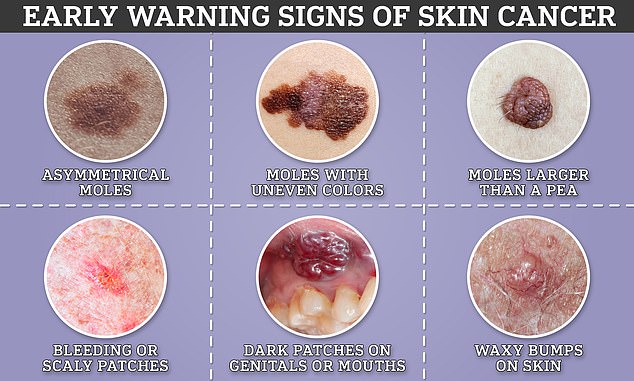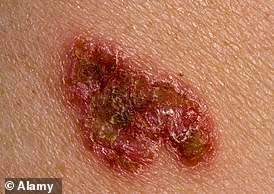Melanoma now no longer the leading cause of skin cancer deaths – these are the signs you need to watch out for
The basic rule for a day at the beach or lounging by the pool has always been to lather up with SPF to protect yourself from skin cancer-causing UV rays.
The more serious type of skin cancer, melanoma, has long been enemy number one. However, a recent study by European dermatologists found that less deadly types of skin cancer now account for the majority of deaths overall.
Non-melanoma skin cancers (NMSCs), such as basal cell carcinoma and squamous cell carcinoma, accounted for more than three-quarters of all skin cancer cases in 2020 and resulted in nearly 64,000 deaths. Around 57,000 people have now died from melanoma.
Scientists believe that the true impact of this disease may be even greater than previously thought because NMSCs are often underreported.
While melanomas typically appear as moles in multiple shades of brown with irregular edges, cancers that are not melanomas can be more difficult to detect and may manifest as waxy, skin-colored bumps or red, scaly patches of skin that may look quite harmless at first glance.

Signs of skin cancer range from harmless to obvious. But experts warn that early treatment is crucial to ensure it does not spread or progress
Skin cancer is estimated to be the most common cancer in the United States one in five Americans expect to develop skin cancer in their lifetime.
Dr. Thierry Passeron, study co-author and dermatologist at Nice University Hospital in France, said: “Although NMSC is less likely to be fatal than melanoma skin cancer, its prevalence is significantly higher.”
“The significantly higher incidence of NMSC has therefore led to a more substantial overall impact.”
The study, which used data from the World Health Organization’s International Agency for Research on Cancer, found a “high incidence” of skin cancer in fair-skinned and older populations in the US, UK, Germany, France, Australia and Italy.
However, the researchers said that even countries with a high proportion of people with darker facial features were not immune to the risk of dying from skin cancer, as shown by the recorded 11,281 deaths in Africa.
In 2020, nearly 1.2 million NMSC cases were reported worldwide, compared to 324,635 melanoma cases.
Most cases of skin cancer are non-melanoma diseases. These are a group of cancers that develop slowly in the upper layers of the skin. The most common forms include basal cell carcinoma and squamous cell carcinoma.
Compared to melanoma, a type of skin cancer that develops in melanocytes – cells that produce melanin, NMSCs are less likely to spread to other parts of the body and are easier to treat.
Dr. Passeron added: “As alarming as these numbers are, they may actually be underestimated.”
“NMSC is often under-reported in cancer registries, making it difficult to understand the true burden.”
The research team not only examined the overall burden of skin cancer, but also identified specific groups who are at higher risk of this disease.
These included people who work outdoors, organ transplant recipients and people with the skin disease xeroderma pigmentosum – an inherited condition involving extreme sensitivity to the sun.
But a robust workforce of dermatologists didn’t seem to make a significant difference.
Dr. Passeron said: “Our study found no consistent evidence that more dermatologists per capita could reduce mortality rates.”
“Surprisingly, countries such as Australia, the UK and Canada with fewer dermatologists had low mortality to incidence ratios.” “We therefore need to investigate what strategies these countries use to further reduce the impact of skin cancer.”
Dermatologists follow the ABCDEs when diagnosing melanoma; that is, asymmetry, edge, color, diameter and development.
Most melanomas, the rarest but most dangerous form of skin cancer and the most likely to spread, appear as moles with uneven edges.
But basal cell carcinomas, which typically occur on sun-exposed parts of the body such as the hands, neck, arms and legs, often appear as a waxy bump or a small, smooth, shiny or pale growth.
However, it does not always appear raised and may resemble a flat scar.
Another type of non-melanoma, squamous cell carcinoma, typically appears as a red, scaly patch of skin that sometimes bleeds. It may also appear as a raised scar.
People who have had heavy exposure to the sun in the past are most likely to develop this type of skin cancer.
With every bad, blistering sunburn, the risk of squamous cell carcinoma increases.
Fair-skinned people and people with light eyes, who are more prone to sunburn, are also more susceptible to squamous cell carcinoma.
However, in most cases, squamous cell carcinoma is curable if treated early. In fact, the survival rate is up to 98 percent.
Dr. Passeron said: “Skin cancer is preventable and treatable, so we must do more to ensure we stop the progression of this disease as early as possible to save lives.”
“We need to spread the message that not only melanoma can be deadly, but also NMSC.”
This, he said, requires educational campaigns that target not only populations that may already know the importance of sun protection, but also people with darker skin tones who are not at high risk for skin cancer
The results are to be presented at the congress of the European Academy of Dermatology and Venereology (EADV) in Berlin.


